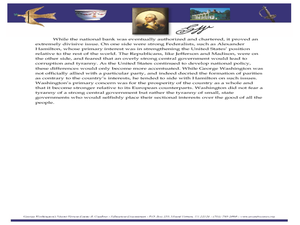Curated OER
The Price of Power
Explore the current political debate over regulating power plant emissions. Critical thinkers research, formulate, and present arguments regarding selective catalytic reduction systems for coal-burning plants.
Curated OER
Leaders & Leadership: A Political Power Structure from Washington to West KY
Though outdated (the presentation names members of the Bush Administration as current political leaders), these slides could be useful to an industrious teacher who is willing to update the information in the Executive, Judicial, and...
University of North Carolina
Political Science
The right to vote and freedom of expression are democratic principles that fall under the study of political science. A handout describes writing assignments that are common in political science college classes and gives tips and...
Savvas Learning
Political Parties
What is a political party, and what major parties exist in American politics today? How did the party system develop in American history, and how are parties organized? These questions and many other details regarding the political party...
College Board
Balance of Power Between Congress and the President
Three branches of government help create a system of checks and balances. A helpful resource provides a series of articles regarding the balance of power between the legislative and executive branches of government. Historians answer...
Curated OER
Using Political Cartoons to Understand Historical Events
Examine historical perspectives through the use of political cartoons. Learners complete analysis activities related to the president's title, the establishment of the national bank, and the Jay Treaty.
Prestwick House
Rhetorical Devices in Political Speeches
Have you ever watched a political speech and felt your heart beat a little faster, and your opinion either solidify or begin to slightly change? Rhetorical devices can be a strong tool in an effective and powerful speech. A short lesson...
Curated OER
Cartoons for the Classroom: Politics of Change
Empty rhetoric in Washington timelessly inspires political cartoons. Examine this concept through an analysis handout, which features a cartoon by Pat Oliphant (archived work is linked for possible extension activities). Although this...
National Constitution Center
Separation of Powers
Learners explore how the Constitution provides for separation of power and limited government, as evidenced by the three branches of government. They participate in role-playing situations, group discussions, and complete worksheets to...
Judicial Branch of California
The Power of the Press: The First Amendment
Was what happened in 1886 at the Haymarket riot a crime or a case of xenophobia? Using political cartoons from the time, young historians consider the role the media played in anti-labor sentiment during the time and how that influenced...
Eastconn
Learning to Analyze Political Cartoons with Lincoln as a Case Study
Discover the five main elements political cartoonists use—symbolism, captioning and labels, analogy, irony, and exaggeration—to convey their point of view.
Curated OER
Cartoons for the Classroom: Sunshine Week
Do the people have the right to know? Is there a real dialogue between U.S. political powers and the American people? Upper graders evaluate these concepts and more when they critically examine two political cartoons depicting Sunshine...
Classroom Law Project
What do cartoonists see in this election?
Cartoons from the 2008 Presidential election provide the text for a lesson designed to help learners understand how political cartoonists use persuasive techniques to present a point of view.
Curated OER
Political Parties and What They Do
The emerging politicians in your government might be familiar with the words "Democrat" and "Republican," but what do they really know about the role of political parties in America? Use this activity to reinforce information from your...
Curated OER
President Bush Balances Power
Students review the results of the November 2006 mid-term election. Using their text, they read the history of the balance of power and examine recent news articles. They present their findings to the class and may even hold a debate.
Curated OER
The Organization of Political Parties
Challenge the future world leaders in your class with this activity, which tests their knowledge on the organization of modern political parties. Students can access their prior knowledge of current elections, or notes from your lecture,...
Curated OER
Art in Nazi Germany When Art and Politics Didn't Agree
Five lessons display the art created by Germans under the Weimar Republic. The focus of these lessons is to help learners understand the role of art in politics, government censorship, and Nazi tactics. Web links are included.
School Improvement in Maryland
Dividing the Powers of Government
Who does what? To develop an understanding of the balance of power between the US federal and state governments, class members research responsibilities in terms of legal systems, security issues, economic activities, lawmaking, and...
City University of New York
Urban Politics: Machines and Reformers
What were political machines and whom did they serve? As part of a study of US immigration patterns and how these patterns influenced politics, groups investigate how Tammany Hall and other political machines gained support from voters.
Curated OER
Women in Power
Learners read a five-paragraph article about female political leaders of the world then respond to five short-answer questions. They also work through a series of vocabulary-building exercises. A glossary is included.
Museum of the Moving Image
Playing on Emotions: Focus on Political Ads Featuring Children
Political ads are designed to play on viewers' emotions. The focus of this resource is on ads that feature children, either to establish the candidate as family friendly, or to create fear for children in the minds of viewers. Groups...
Curated OER
Lesson: Unmonumental: War, Politics, and Protest
Get those upper graders thinking about the world, social conflict, and art as a catalyst for change. They'll uncover the meanings behind four abstract works, intended to spread awareness of the need for social change. Kids are then asked...
Annenberg Foundation
Electoral Politics
You won't just get a lesson when you click on this resource. As you click on the related resources located to the left of the screen, you'll find, a professional development video, teacher/student notes, lesson plan, and related reading...
Curated OER
Redistricting: Drawing the Lines
Difficult redistricting concepts are covered in a context that will make it understandable to your government scholars. They begin with a KWL on the term redistricting and then watch a video to answer some questions. They analyze...
Other popular searches
- Political Power Units
- Political Power and Behavior
- Political Power in America
- Political Parties Powerpoint
- Extending Political Power

























